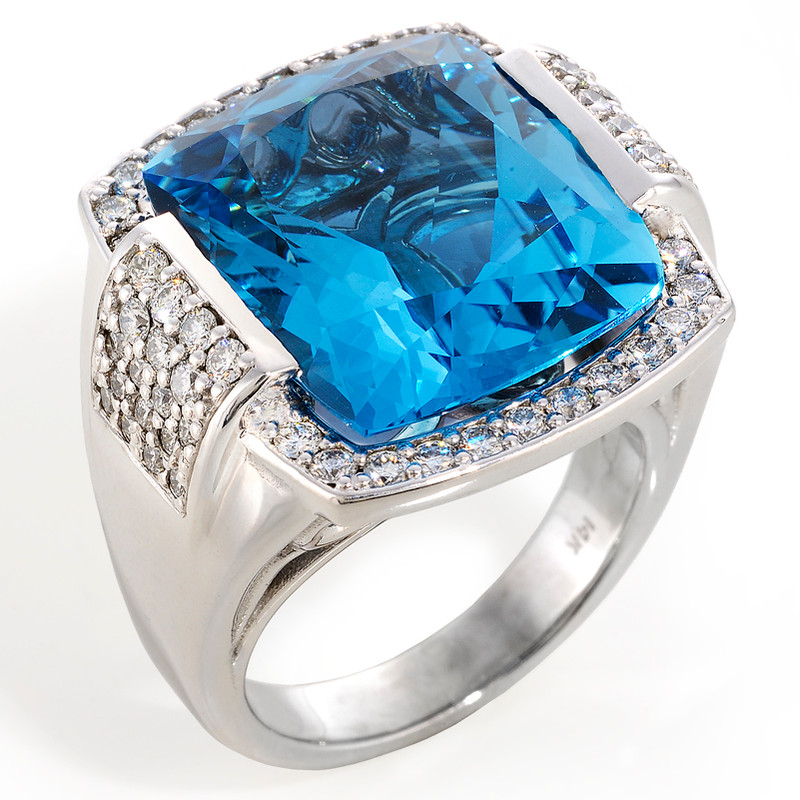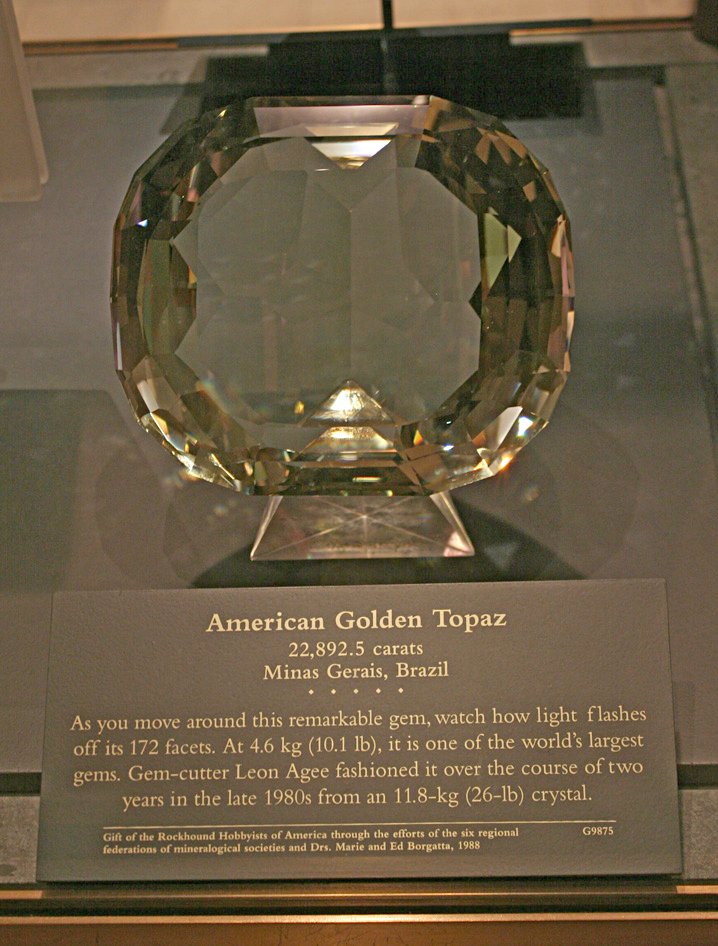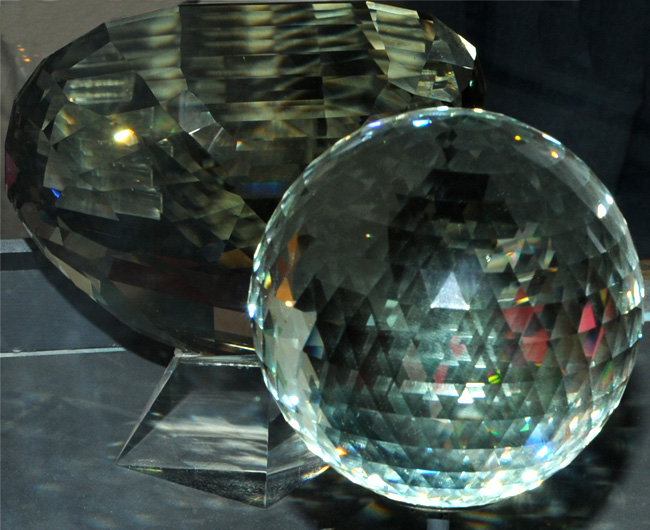Those of you with November birthdays have 2 beautiful birthstones to choose from; topaz and citrine. Topaz features an appealing array of colors, while citrine is prized for its charming yellow to orange hues. Both are known to have calming energies while bringing fortune and warmth to the wearer. Many topaz and citrine birthstones are affordably priced, which means those of you born in November have two excellent options. This blog covers topaz, while citrine is discussed in its own blog.
Topaz’s warm, cool tones - honey yellow,
fiery orange, cyclamen pink (a light crimson color of the cyclamen flower), icy
blue - makes it a very versatile gemstone for jewelry use. Click the link to browse 100 East Fine Jewelry’s topaz collection. Some of
our recent designs include these outstanding blue topaz pieces. 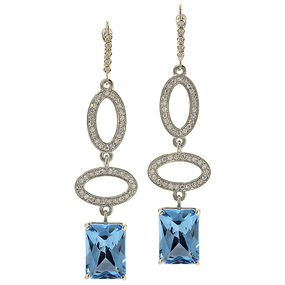
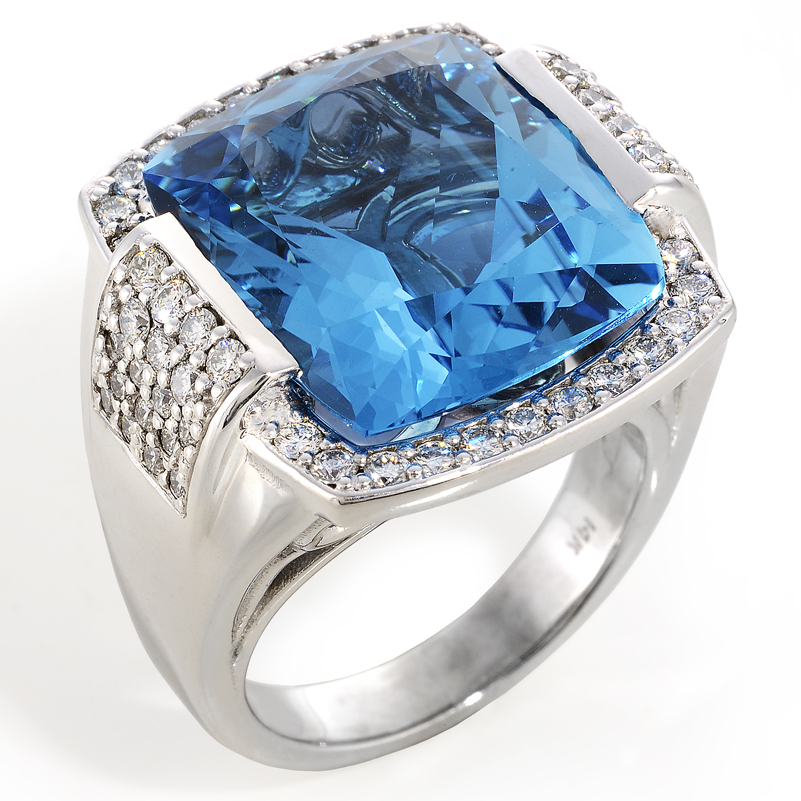
Many consumers know topaz only as a plentiful sky blue gemstone, like the blue topaz jewelry shown above. What they may not know is its color is hardly ever natural. It is almost always created by treatments of natural colorless and brown topaz. Some natural topaz is considered fine gems, such as those found in golden, orange, pink, red and purple colors.
Topaz’s color varieties are normally identified simply by hue name. Thus you’ll encounter blue topaz, yellow topaz, and so forth. However, some people in the trade have given certain topaz varieties special trade names. Be aware, however, there is significant disagreement among members of the trade as to how these terms are defined:
Imperial Topaz – This term is widely used in the trade. Two origin stories are cited for the trade name imperial topaz. The most common story is the name originated in 19th century Russia, where at that time the Ural Mountains were a leading topaz source. It is believed the name arose from the Russian royal family’s insistence on keeping the finest pink color exclusively for their private use.
An alternate explanation, especially popular in Brazil, is the trade name imperial topaz dates from an 1881 visit by Brazilian Emperor Pedro II to Ouro Preto, Brazil, the town closest to the country’s most productive topaz mines. A reddish topaz was gifted to him, which resulted in that variety being designated imperial topaz.
In addition to pink and reddish colors defining imperial topaz, numerous other color concepts have been cited by members of the trade, such as:
- The color of the setting sun
- Pinkish orange
- Orangey-pink to pinkish red
- Orange to pink to red to purple
- Brownish-yellow to orange-yellow
- Cut and polished stones that show a reddish pleochroic color at the ends of pear and oval shaped fashioned gems with otherwise yellow-to-orange bodycolor. (Pleochroism is when the gem shows different colors when the stone is turned in different crystal directions.)
The Gemological Institute of America’s (GIA) guidance on defining imperial topaz is: “There is no official standard for imperial topaz. Some dealers use the term for colors that are orange to pink to red to purple; others reserve the term for certain saturated shades. It’s the color, not the term “imperial,” that gives topaz its value.”
Sherry Topaz - this trade name results from the similarity of the stone’s color to that of sherry wine; orange to yellow to brown topaz.
Precious Topaz – appears to be an alternative trade name for stones with roughly the same colors as sherry topaz. The intent of this additional trade name is reportedly to help distinguish stones of the yellowish brown or brownish yellow to orange color range from less expensive citrine or smoky quartz, which look similar to, and are frequently misrepresented as, topaz.
Bottom line - I follow GIA’s advice when considering all topaz varieties and focus on the stone’s color, rather than a trade name.
Topaz is also used to commemorate the 23rd wedding anniversary, symbolizing love, truth and devotion.
History and Lore
Most authorities agree the name topaz was taken from the ancient Greek island of Topazios in the Red Sea. It is now part of Egypt and called Zabargad (St John’s Island in English). The ironic part is the island is not believed to ever have produced topaz. The earliest surviving written records indicate ancient Egyptians may have begun organized peridot mining on Topazios thousands of years ago. It is theorized that some of the early peridot mined there may have mistakenly been called topaz. Other scholars believe the origin of topaz’s name can be traced to Sanskrit (an ancient Indian language) words topas or tapaz, meaning “fire.”
Confusion surrounding topaz continued for centuries, especially with the yellow-to-orange varieties. A misconception existed that all yellow gems were topaz and that all topaz was yellow. Citrine and even smoky quartz were often mistaken as topaz.
Topaz was, throughout time, the subject of much lore. It was acknowledged to fuel matters of the heart, inspire courage, increase intuition and sharpen wit. It was also thought that topaz could sweeten dreams and dispositions. The gemstone of friendship, topaz was supposed to reveal the gracious and charismatic qualities of those who wore it.
Ancient Egyptians believed topaz gemstones were colored by the glow of one of the most important gods in the Egyptian religion, the sun god, Ra. For centuries, many in India felt topaz worn above the heart assured long life, beauty, and intelligence. Ancient Greeks credited topaz with the power to increase strength and make its wearer invisible in times of emergency. In Renaissance Europe, it was commonly thought that topaz could break magic spells and dispel anger.
Use in Jewelry Today
Topaz is quite common in today’s jewelry market, particularly the blue and yellow colors. It comes in a wide range of shapes and sizes. Topaz is regularly cut into larger sizes, providing jewelry designers the opportunity to make statement pieces at very affordable prices.
From a pure hardness standpoint, topaz is one of the harder gemstones. However, like diamond, topaz is subject to cleavage, which means it might split apart when receiving a hard blow from certain directions. When used in rings and bracelets, to minimize cleavage potential, topaz should be set in protective mountings. When mounted in pins, necklaces, pendants and earrings, they are quite appropriate for everyday wear.
High heat or sudden temperature changes can also cause breaks in topaz. The gem’s color is generally stable to light, but prolonged exposure to heat or sunlight might cause fading in some yellow-to-brown, reddish brown, or dark brown topaz. Topaz may be affected slightly by some chemicals.
A man-made product known as mystic topaz is also used for jewelry. Mystic topaz is made by coating colorless topaz with a microscopic layer of metallic oxide compound which creates the appearance of a variety of iridescent colors. The coating is not very durable. It can resist daily wear and tear, but is subject to scratching. Abrasive cleaners or buffing wheels used in jewelry repair can remove the coating.
Because high heat and sudden temperature changes can cause breaks in topaz jewelry, steam cleaning or ultrasonic cleaners are not recommended. We believe all your gemstone jewelry is best cleaned with warm, soapy water and a soft brush. We consider this a single, safe method to use for cleaning all gemstone jewelry. For additional details, please read our blog; Cleaning Fine Gemstone Jewelry. To learn about caring for all your fine jewelry, please read our blog; Caring for Fine Gemstone Jewelry.
Despite the above care considerations, fine topaz is a beautiful gem that offers a range of warm, attractive colors in large sizes that are often free of visible inclusions or flaws.
Color Characteristics and Treatments
Topaz has an exceptionally wide color range which in addition to brown, includes various tones and saturations of blue, green, yellow, orange, red, pink, and purple. The value of each hue depends on the stone’s color saturation. The rarest topaz colors are natural pink, red and fine golden orange. While red is one of the most sought-after topaz colors, it represents a very small amount of facet-grade material. Brown is a common topaz color, and is sometimes mistakenly identified as “smoky quartz.”
Blue topaz gems are widely available, but its color is rarely natural. It’s almost always caused by treatment. Depending on the treatment and the starting material, many shades of blue topaz can be found in the market.
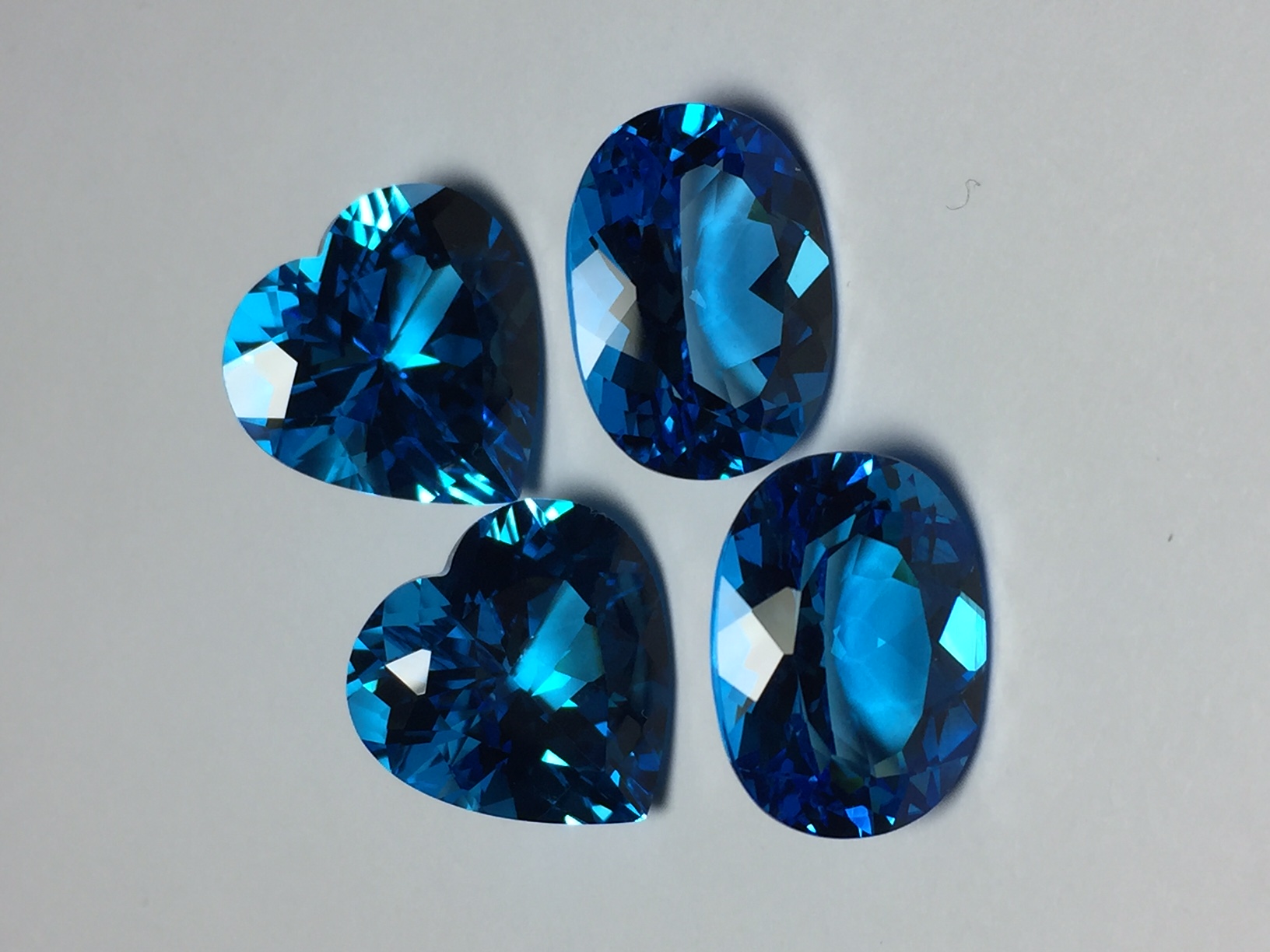
The element chromium causes natural pink, red, and violet-to-purple topaz colors. Imperfections at the atomic level in the topaz crystal structure can cause yellow, brown, and blue color.
A fashioned topaz that displays a combination of two colors is known as bicolor topaz. Topaz is also pleochroic, meaning the gem can show different depths of color or even different colors in different crystal directions.
Heat
treatment, the exposure of a gem to high temperatures for the purpose of altering
its color and/or clarity, is possible with yellowish pink topaz. It sometimes removes the yellowish
color component, thereby intensifying the pink color. Heat treatment is
considered durable and permanent under normal handling conditions.
Most topaz crystals are colorless. Natural blue colored
topaz is extremely rare. However, as mentioned above, blue topaz has been considered
a mass-market gem since the 1970’s when extensive treatments of colorless topaz
was developed. After being extracted from the
earth and cut, colorless topaz is irradiated to a brown color and then heat
treated to blue. This combination of treatments is considered stable and permanent. If you are concerned about the safety of irradiated gemstones, our article entitled "Are Irradiated Gemstone Safe to Wear" cover sthis topic.
Besides irradiation and heat treatment, another common treatment of topaz is coating to create mystic topaz. Care should be taken not to allow any hard or abrasive objects to come into contact with coated gems as they’re susceptible to scratching, particularly along facet edges and junctions. While on a cruise, a friend of mine encountered a similar product called Carribean topaz. You can read the story here Surface Coating of Gemstones Explained.
Topaz, as is the case with any number of transparent gemstones with surface-reaching fractures, can potentially be treated by filling the fractures with resins and glasses. The durability of this treatment depends on the filler material. Glasses tend to be harder and therefore more durable than resins, oils or waxes. Special care is required if the topaz has filled fractures. Avoid exposure to heat, and changes in air pressure (such as in an airline cabin), or chemicals.
Formation, Mining and Cutting
Topaz often forms in cavities in igneous rocks as large crystals which are usually elongated columnar shapes with strong grooves along the length. below is a photo of a topaz crystal.
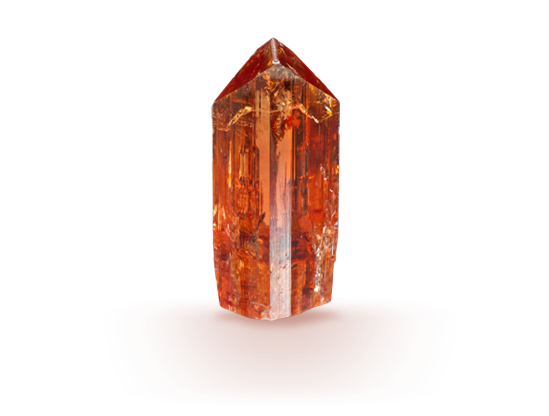
Photo courtesy of GIA
In fact, topaz crystals are some of the gem world’s largest; being measured in kilograms, not carats. A transparent topaz crystal discovered in Minas Gerais, Brazil weighs an astounding 270 kg (596 lbs).
Today, Brazil is the world’s leading producer of gem-quality topaz. Other major producing countries include Russia, Pakistan, and Sri Lanka. Topaz is also mined in Madagascar, Myanmar, Namibia, Zimbabwe, Mexico, China, Nigeria, India, Australia, U.S (California, Utah, Texas and Colorado) and Europe (mountain ranges in Germany, Czech Republic, Italy, Norway and Sweden).
The Brazilian state of Minas Gerais is one of the most important sources for fine topaz. For more than two centuries, its mines have yielded yellow to orange, red, pink, violet and blends of red and orange or purple topaz. Russia’s Ural Mountains is another top source. Northwestern Pakistan is known for its pink topaz, including what some in the gem trade call cyclamen pink, a shade which contains a hint of violet. Brazil and Sri Lanka are major sources of treatable colorless topaz.
Topaz’s large crystal sizes can result in sizable cut gemstones. They can be found in a wide variety of shapes and styles, including all the standard gem shapes (ovals, pears, rounds, cushions, triangles, marquise, and emerald cuts) as well as designer-inspired fantasy shapes. Because of topaz’s columnar crystal shape, cutters tend to favor oval or pear shapes to optimize yield. Below is a photo of a polished topaz gemstone.
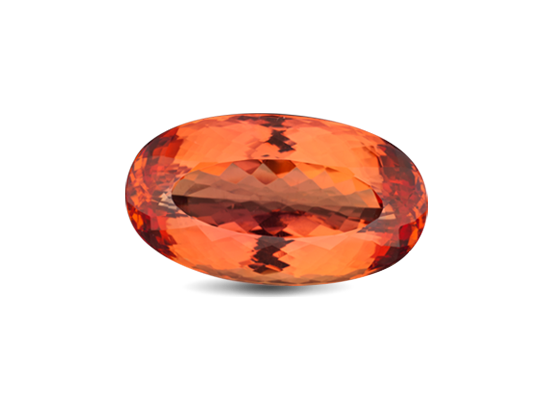
Photo courtesy of GIA
If the rough is strongly colored, the cutter may opt for the emerald cut because that style results in the highest yields. When selecting topaz gemstones that are cut in an elongated shape, color sometimes concentrates in the ends of gemstones.
Faceted topaz takes such a high polish it’s slightly slippery to the touch. Because of the potential for topaz to cleave, special care is required when cutting, polishing and mounting
Famous topaz:
- American Golden – this 22,892.5 carat faceted gemstone, one of the world’s largest, is in the collection of the Smithsonian Institution, National Museum of Natural History. It weighs 12.3 pounds and is reported to be as large as an automobile headlight.
- Adiel Topaz – cut by Richard Homer, this 20,769 carat gemstone took one year to cut. It’s in the collection of the Field Museum of Natural History.
- 12,555 Carat Sphere – this faceted topaz sphere is in the collection of the Smithsonian Institution, National Museum of Natural History
- The Brazilian Princess Topaz, a 21,327-carat (9 lb. 6 oz.) flawless light blue gem is considered to be one of the largest cut gemstone in the world. It was discovered in the Brazilian mountains near Teofilo Otono. It was on loan to the Smithsonian's National Gem Collection by an anonymous donor.
Credit American Gem Trade Association, Gemworld International and Gemological Institute of America.

